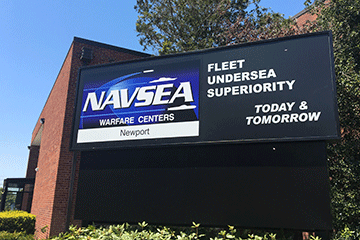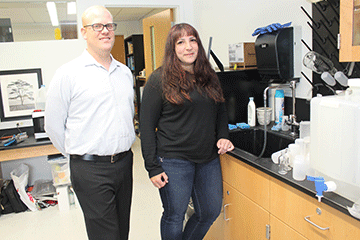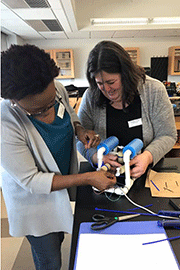
04/09/2019
SUNY Cortland is studying how to translate military research ideas and practices into relevant science, technology, engineering and math curriculum for secondary schools. Those lessons, developed and shared with the help of some of Central New York's most talented educators, aim to help create an environment in which high school students are better prepared and eager to pursue the science and technology careers of the future.
The College was awarded a $610,210 grant last fall from the Office of Naval Research for a three-year study, “Engaging the Next Generation STEM Naval Workforce: Using Communities of Practice to Build Capacity.” Central to the project is work with the renowned Naval Undersea Warfare Center (NUWC) in Newport, Rhode Island, and New York state's Master Teacher program, for which SUNY Cortland is a hub.
“The idea is that we’re using Naval resources to create curriculum that is based in authentic science, technology, engineering and mathematics (STEM) experiences,” according to Dominick Fantacone M.A.T. ’12, the Central New York regional director and the statewide assistant director for regional operations for the New York State Master Teacher Program and co-investigator on the project.
A key component of attracting students into and preparing them for STEM fields is teachers who can actively engage students in curriculum that is relevant, promotes application of technical skills and data analysis, and encourages critical thinking.

“In order to do that, teachers and our teacher candidates need to have a good sense of what that process looks like,” Fantacone said. “And that’s the partnership with NUWC Newport. Working directly with personnel from there, they can see how these principles are applied in actual settings.”
“The methodology of our pilot study is unique in that we intend to create a community of practice, a social learning structure, that will include Naval researchers, both government and industry, currently practicing teachers, teachers in training and faculty in the sciences,” said Angela Pagano, an associate professor of biological sciences at SUNY Cortland and lead investigator on the grant.
This approach is one that holds great promise to improve the capacity of teachers to integrate STEM research into their classes, noted Pagano, citing a National Science Foundation statistic that only 7 percent of high school science teachers surveyed felt prepared to integrate engineering into their curriculum.
Pagano and Fantacone recently accepted 15 New York State Master Teachers into phase I of the project.
Launched by Gov. Andrew Cuomo in 2013, the highly selective New York State Master Teacher Program includes more than 950 STEM teachers across 9 regions. They are chosen for their classroom effectiveness, a commitment to personal growth, and a willingness to mentor new teachers as well as future educators.
SUNY Cortland serves as the Central New York regional hub for the Master Teacher Program, working with more than 100 teachers, an indicator of the College’s leadership in advances in teacher education.
Master Teachers, working with the NUWC researchers, will define specific STEM areas to hone in on.
“The first year is the planning and development year,” Pagano said. “In the second year, we’ll have a group of teacher candidates work with the Master Teachers on initial design and implementation of lesson materials and activities. In the final year, we will use what we learned to refine these materials, providing a second cohort of teacher candidates the opportunity to engage in lesson design with Master Teachers.”
Out of this partnership, the Navy stands to gain more future scientists and engineers to keep American military might on the cutting edge.
And schools will receive educators able to prepare their middle and high school students for a real working environment with in-demand STEM professions.
“What we’re trying to do is more broadly create communities where teachers, teacher candidates and researchers work collaboratively to drive innovations in curriculum development,” Pagano said.
“We’re hoping that the communities of practice established will continue on beyond this grant,” Fantacone said.
Pagano and Fantacone were on hand in May 2017 when SUNY Cortland signed an educational partnership agreement with NUWC Newport.
Although NUWC exists for military research carried out by U.S. government personnel, the facility has a long tradition of partnerships with civilians through universities around the country.

The College was the first in the SUNY system to have such an agreement with NUWC Newport, the Navy's research, development, evaluation, engineering and fleet support center for submarine warfare and many other systems associated with the undersea battlespace. The initiative was fostered by David Duryea, the former SUNY Cortland vice president for finance and management and a retired U.S. Navy rear admiral.
In Spring 2017, Pagano and Fantacone were among five SUNY Cortland representatives who took a private tour of the Navy research facilities. The visit was led by enthusiastic military scientists and engineers who gave the campus contingent an idea of the areas in which faculty and students might become involved.
In early 2017, Fantacone and Pagano facilitated a workshop for Master Teachers and SUNY Cortland Physics Club students, featuring a visiting NUWC technical director, that explored SeaPerch, an underwater robotics project. Fantacone’s interest has been the professional development opportunities for the Master Teachers that focus on engaging, relevant, and current STEM topics. The Navy’s interest in unmanned underwater vehicles, biomimicry, and underwater acoustics are examples of the types of things participating teachers will explore.
“This project will expose participating teachers and teacher candidates to the many naval STEM career opportunities available to their students — opportunities they may not have otherwise been aware of due to the lack of a Navy presence in Central New York,” Pagano said.